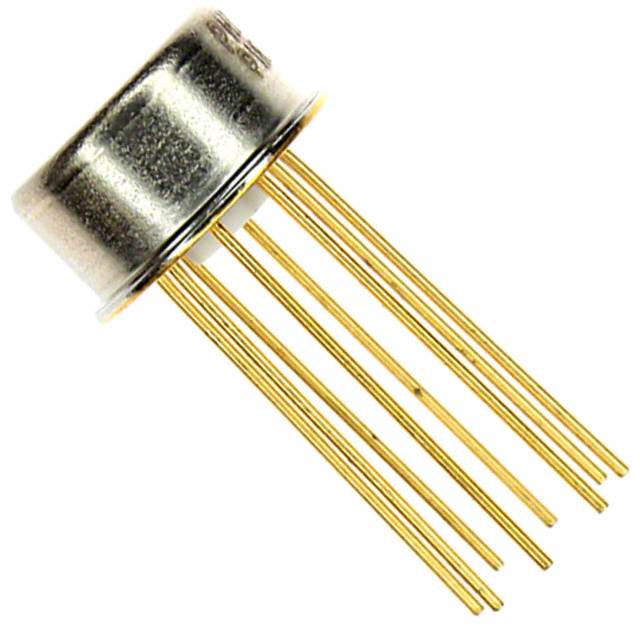OP77FJZ
Basic Information Overview
- Category: Integrated Circuit (IC)
- Use: Operational Amplifier
- Characteristics:
- High gain and bandwidth
- Low input offset voltage
- Wide supply voltage range
- Low power consumption
- Package: Dual in-line package (DIP)
- Essence: Analog signal processing
- Packaging/Quantity: Typically sold in reels of 1000 units
Specifications
- Supply Voltage: ±15V
- Input Offset Voltage: 1mV max
- Input Bias Current: 10nA max
- Gain Bandwidth Product: 1MHz min
- Slew Rate: 0.5V/µs min
- Output Current: 20mA max
- Operating Temperature Range: -40°C to +85°C
Detailed Pin Configuration
The OP77FJZ has a total of 8 pins arranged as follows:
```
| | --| V+ V- |-- --| IN+ IN- |-- --| OUT NC |-- --| NC VCC+ |-- --| NC VCC- |-- |___________| ```
Pin Description: - V+: Positive supply voltage - V-: Negative supply voltage - IN+: Non-inverting input - IN-: Inverting input - OUT: Output - NC: No connection - VCC+: Positive power supply - VCC-: Negative power supply
Functional Features
- High precision amplification of analog signals
- Low distortion and noise
- Wide dynamic range
- Stable performance over temperature variations
- Suitable for various signal conditioning applications
Advantages and Disadvantages
Advantages: - High gain and bandwidth allow for accurate signal amplification - Low input offset voltage ensures minimal error in signal processing - Wide supply voltage range enables flexibility in power supply selection - Low power consumption for energy-efficient operation
Disadvantages: - Limited output current may restrict certain applications - Relatively low gain bandwidth product compared to some modern alternatives
Working Principles
The OP77FJZ is an operational amplifier that utilizes differential input stages, gain stages, and output stages to amplify and process analog signals. It operates based on the principles of negative feedback, where the difference between the input and feedback signals is amplified to produce the desired output.
Detailed Application Field Plans
The OP77FJZ is commonly used in various applications, including: 1. Precision instrumentation 2. Data acquisition systems 3. Medical equipment 4. Audio amplification 5. Industrial control systems
Detailed and Complete Alternative Models
- OP27: Offers improved specifications with lower input offset voltage and higher gain bandwidth product.
- OP37: Provides higher output current capability while maintaining similar performance characteristics.
- LT1115: Offers ultra-low noise performance for demanding audio and measurement applications.
- AD8671: Provides rail-to-rail input and output capabilities for enhanced versatility.
These alternative models offer different trade-offs in terms of performance, power consumption, and cost, allowing users to select the most suitable option for their specific requirements.
Word count: 386 words
Senaraikan 10 soalan dan jawapan biasa yang berkaitan dengan aplikasi OP77FJZ dalam penyelesaian teknikal
Sure! Here are 10 common questions and answers related to the application of OP77FJZ in technical solutions:
Question: What is OP77FJZ?
- Answer: OP77FJZ is a specific model or type of electronic component used in technical solutions, particularly in industrial automation and control systems.Question: What is the purpose of using OP77FJZ in technical solutions?
- Answer: OP77FJZ is typically used as an operator panel or human-machine interface (HMI) in technical solutions to provide a user-friendly interface for controlling and monitoring various processes or equipment.Question: What are the key features of OP77FJZ?
- Answer: Some key features of OP77FJZ include a high-resolution display, touch screen functionality, multiple communication ports, programmable function keys, and compatibility with various industrial protocols.Question: Can OP77FJZ be used in harsh environments?
- Answer: Yes, OP77FJZ is designed to withstand harsh industrial environments and is often rated for high levels of shock, vibration, temperature, and humidity.Question: How is OP77FJZ programmed?
- Answer: OP77FJZ can be programmed using specialized software provided by the manufacturer, which allows users to create custom screens, define control functions, and configure communication settings.Question: What types of applications can OP77FJZ be used for?
- Answer: OP77FJZ can be used in a wide range of applications, including process control, machine automation, manufacturing, energy management, building automation, and more.Question: Is OP77FJZ compatible with other automation systems?
- Answer: Yes, OP77FJZ is designed to integrate with various automation systems and can communicate with programmable logic controllers (PLCs), distributed control systems (DCS), and other devices using standard industrial protocols.Question: Can OP77FJZ be connected to a network?
- Answer: Yes, OP77FJZ usually has built-in Ethernet or serial communication ports, allowing it to be connected to local area networks (LANs) or other networked devices for remote monitoring and control.Question: Are there any limitations or considerations when using OP77FJZ?
- Answer: Some considerations include the display size, processing power, and memory capacity of OP77FJZ, which may limit the complexity of applications or the number of screens and objects that can be used.Question: Where can I find technical support or documentation for OP77FJZ?
- Answer: Technical support and documentation for OP77FJZ can usually be obtained from the manufacturer's website, including user manuals, programming guides, application examples, and troubleshooting resources.
Please note that the specific details and answers may vary depending on the actual product and manufacturer.


